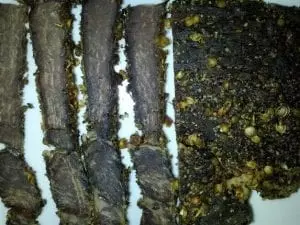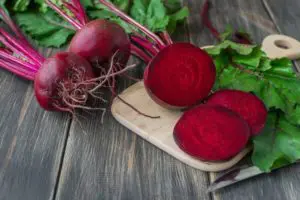When I walk around the supermarket fruit aisles, all I see is ever increasing prices for a shrinking array of fresh produce. It seems like there is an attempt to groom ordinary consumers into creatures of habit buying certain premium product lines which are easy to manage with long shelf lives just to allow for continuity and maximum profits.
Furthermore, inner city fresh fruit is starting to become food for the wealthy only, meaning the privileged class are the only ones eating a healthy diet whilst the poor or middle classes overlook the fresh gourmet fruit like mangoes or avocados to buy bread, pastries, and processed food. And speaking about processed food, why are canned mangoes in sugar syrup cheaper to buy than fresh? COME ON!

Long oval fruit from the thorny finger lime tree are a sensational flavour burst eaten straight or used in drinks and cooking (image above)
Anyway, the cost of fresh food is a debate for another article – I just got a bit fired-up writing this intro… However, I will say the unreasonable rising cost of fresh fruit, the lack of product diversity, and supermarkets snubbing local growers for cheaper imports, are three major reasons for why we moved out of the city and started growing our own fruit. That's right, a variety of healthy, affordable, local, fresh, free from chemicals, good fruit is extremely important to me and my family. Actually, it should be important for every one and every family because those with a scant fruit diet are running a serious risk of a premature death simply due to a lack of vitamins and nutrients through improper eating.
Our own fruit tree journey
So far during our own self-sufficient journey here in Bellmere, we have collected over 70 dedicated fruit trees on our small 3 acre property – and our mission of planting more fruit trees is not over y et. This number of fruiting plants does not include fruiting shrubs and smaller non-perennial plants like Rosella or tomatoes, for instance. When we first moved here only 8 years ago we inherited three fruit trees: 1 x mango (Bowen); 1 x orange (Washington); and 1 x mandarin (an easy peel variety).
et. This number of fruiting plants does not include fruiting shrubs and smaller non-perennial plants like Rosella or tomatoes, for instance. When we first moved here only 8 years ago we inherited three fruit trees: 1 x mango (Bowen); 1 x orange (Washington); and 1 x mandarin (an easy peel variety).
Pretty soon we realised the mango tree was susceptible to anthracnose, which is a disease that drastically hampers fruit development, so we hardly got any fruit from it. Also, the Washington orange and mandarin tree were severely undernourished and were almost dead when we first moved into our new home. However, after a good feed of citrus fertiliser with some trace elements, a good mulching, and regular water, both trees quickly developed into amazing fruit producers. Two out of three fruit tree successes ain’t too bad…
More importantly, those early fruit tree experiences on our new property were very valuable because it gave some important clues to successfully starting our diverse fruit tree “orchard.” Firstly, the negative, we knew we had a serious plant disease (anthracnose) on our property to contend with; and secondly, a positive, we found a line of fruit trees (citrus) which thrived on our block without much effort on our part at all.

A beautiful grapefruit tree complements the ornamental garden behind (image above)
Therefore, it made sense to play on a strength and plant more citrus trees and at the same time try to choose fruit trees, which have a better tolerance to anthracnose. Both of these initial strategies (although still ongoing) have proven to be winners. I've written specifically about oranges before and there's no doubt our early plantings of different orange trees have not only given us varied tastes but they have also extended harvests and complement each other when one tree has an “off season” (which can happen).
The anthracnose disease example for diversity is even more interesting because rather than give up growing trees susceptible to the disease (like mangoes), I sort different varieties of them also and this a paid off. We now have 8 different varieties of mango – most, specifically selected for having good tolerance to anthracnose. Therefore, we now have mango trees which actually produce fruit and (just like the oranges) our season is extended due to slightly different harvesting times.
I found acquiring different varieties of fruit trees to meet our needs and challenges/growing conditions an exciting venture – I still do I guess. And, I wouldn't necessarily call it a “hobby” either because I'm not obsessed with collecting fruit trees for the sake of it – I'm more about collecting special kinds of fruit trees for only two purposes: to make sure they grow well, and to eat the fruit.
Plenty of fruit trees to choose
That's all good, but diversity within a variety is only part of the game. Diversity through different species of fruit trees is what gives the striving self-sufficient gardener the edge over Ma and Pa Kettle's standard orange, lemon, and lime trees nestled in a neat row behind the clothes line – still, three citrus trees is better than nothing.
Having an orchard full of citrus is hardly diverse and although on our own property we played on this strength at the start, we soon were planting as many different varieties of fruit trees as possible because we needed fruit for most of the year not only in citrus season. Therefore, to get fruit for most of the year, or even all year round, we needed fruit trees which produced fruit at different times of the year.
This is where the wonderful world of fruit really opened up to me. I knew there were many thousands of different fruit trees around the world; however, I never knew how easy it would be to find and buy these exotics for my own yard. More so, I was surprised at how terrific most of these obscure fruits tasted!

Pomegranate flower (image above) this is a very hardy tree that is worth growing for it's exotic fruit
Eating traditional fruits seasonally is great, but growing other fruit trees for eating to fill the gaps between traditional harvests is sensational! After growing and eating some different and unusual varieties of fruits, I realised just how healthy it was to eat a diverse range of fruits in season throughout the year all with their own special micro nutrients, antioxidants, and vitamins.
See, there are plenty of other great fruit trees with awesome ornamental stature and delicious fruit but unless you venture to country markets, or grow your own, you'll never know. People who rely solely on their inner city supermarket for fruit are really only going to get the standard selections time and again because it's too hard and risky for the big retail chains to have lines of fruit which can be inconsistent and have a poor shelf life or poor transportability. Yes, transportability is a real word…
Life is about discovery and discovery through taste is extremely important to most humans. Planting an unfamiliar fruit tree to watch it develop and feel the excitement as it buds, flowers, and the fruit ripens, is a truly satisfying thing to do. And, the experience of tasting your special fruit for the first time or even sharing it with someone makes for a special moment.
Diversity tips for growing fruit trees at home
Here are some random diversity tips for growing fruit trees at home:
-
Diversify to beat diseases – We've already covered this point earlier in this article; needless to say, there are many more varieties of fruit trees then ever before and there are more being cross-bred and developed each year to improve disease resistance. If a tree you have isn't “working” then try an improved or different variety instead.
- Look outside of your climate zone – Along the same lines of fruit tree development for disease resistance above, the boundaries of climate are becoming fuzzy. Low chill stone fruit, apples, and other cold climate trees are able to be successfully grown to produce good quality fruit in warm climates, and what once was typically sub-tropical fruit trees, can now be grown in cooler areas. Furthermore, creating the right micro-climate within whatever climate zone you're in can allow the right conditions for trees outside of your zone to grow. You don't necessarily need a green or hothouse to do this either as micro-climates can be created naturally through clever gardening techniques and the use of other structures (like planting against a brick wall which gets lots of sun).

The image above shows an espaliered olive tree trained across a lattice with herbs growing underneath.
-
Harvest extension – Different varieties of the same species of fruit trees can be grown to extend harvesting times because the fruit ripens at different times. Also, different sizes of fruit can be grown for early harvests; for instance, limes are a small citrus fruit “fast fruit” due to the smaller size so whilst waiting for other larger citrus to ripen, limes are available. Plus, limes can also be used when not fully ripe to flavour food like Asian dishes.
-
Pruning and dwarf – Dwarf fruit trees to suit smaller properties or pots can be purchased for just about any tree these days. However, thoughtful pruning can keep fruit trees from growing to
 o large to handle. More fruit trees kept small are better than less fruit trees left to grow large. Pruned small fruit trees are easier to manage for bird netting or pest control, picking fruit, and take up less space so you can fit more in.
o large to handle. More fruit trees kept small are better than less fruit trees left to grow large. Pruned small fruit trees are easier to manage for bird netting or pest control, picking fruit, and take up less space so you can fit more in.
-
Try something different – Look for different and unusual fruit trees to grow. You might be surprised at how wonderful the fruit tastes! What may be no good to grow commercially, might be fabulous as a single tree in the backyard. Home-grown fruit is not only just healthy but you're also likely to eat more of it because you grew it. Children love picking and eating fruit from the tree (so do adults) and nothing much beats plucking fresh fruit for free off your own trees. The Sunrise lime (right image) was developed by Australia's CSIRO and is a cross between a mandarin/cumquat and native finger lime more info on their website.
-
Trade ornamental trees for fruit – Why take up all the growing space with ornamental trees? Fruit trees can be highly ornamental too. Most fruit trees flower beautifully and have lovely foliage, plus the big bonus is the free fruit after. We don't really have a dedicated “orchard” as such because our garden is riddled with fruit trees wherever we can fit them.
- Environmental – Fruit trees benefit creatures like birds, insects, frogs, and other animals by offering habitat, places to hide, breed, forage, and even fruit to eat. Home-grown fruit uses less energy and resources to get to the “plate.” Organically grown produce saves chemical pesticides and fungicides from being leached into the environment.

A Willy Wag Tail bird sits on a post overlooking a prickly dragon fruit. Birds are a great asset in the garden and most are only after insects and fruit trees are perfect habitats for both (image above).
-
Health – I've written before about the physical health benefits of gardening; and growing fruit trees can be quite physical at times when pruning, mulching, planting, and even picking the fruit. We need physical exercise to keep our own body healthy and strong, especially, as we age. The health benefits of eating a diverse range of fruit is dreadfully under rated. Humans evolved over thousands of years to become the complex being we are because of our varied diet and although will can “survive” on narrow food choices our body will flourish on a varied diet partly made up of many different types of fruits.
-
Maintenance – Having just stated the physical benefits of growing fruit (above), in all honesty, there is little work to be done to keep fruit trees growing. For the majority of time, non-commercial fruit trees just sit there growing away with little attention required. All that is needed is a yearly prune, regular water, the occasional weeding and mulching, and a few handfuls of fertiliser throughout the year.

The unusual Hog Plum is a tropical tree which can be successfully grown in other climate zones (image above)
-
Finding different and unusual fruit trees – Often nurseries will stock the occasional exotic or new variety of traditional fruit trees. Sometimes, just asking or talking to your local nursery about unusual fruit trees can open a new supply line or prompt the retailer to show you a list of trees they don't stock but can order for you on demand. I purchase many of my fruit trees online and online nurseries are getting better and better at packaging plants for delivery via the postal services. Prices for many online fruit trees are often quite reasonable too even with postage factored in and the choices are vast.

-
Free fruit trees – Fruit trees can also be procured from friends, family, gardening clubs, or made yourself via cuttings or seeds. I've grown certain types of fruit trees directly from supermarket fruit just by saving some seed and sowing them in pots. My Uncle has had an edible garden for as long as I can remember and he (and my Aunty) live in suburbia on a standard sized block (about 600m2 ). Their yard is riddled with fruit trees – it's almost jungle like out back! Also, like many other gardeners around the world it's proof you don't need a large farm to grow lots of fruit. My Uncle also propagates many of his own fruit trees and I've been lucky enough to have received several young trees from them in the past, with “special” traits only years of experience and selection can bring.
-
Listen and ask – Advice on growing and what to grow with respect to fruit trees is all around us. Asking other people (especially the older folk) often invokes reminiscing conversations of the fruit trees from their past or childhood. Hints and tips about how to best grow them can be found through these conversations and fruit trees common in the past but now vague memories can be found and resurrected as a new tree to be enjoyed on your property by this generation.
Conclusion
Apart from some places on Earth with climatic extremes, most locations around the world are able to grow a range of fruit trees to flower and bear fruit in every season. Aim to diversify with the main purposes being to insure against losses, disease, and off-seasons, and to enjoy an enhanced varied diet with the ability to eat fresh fruit all year round.
Don't become a complete slave to only what the supermarket shelf offers and give yourself the satisfaction and health benefits to indulge in your own “fruits of labour” with different varieties of fruit trees mixed with traditional crops in your own yard.
Not only will you be benefiting yourself and family but you'll also be helping the environment and perhaps giving new life to an exotic tree long neglected by the major grocery chains simply because it wasn't economical to stock the fruit on their shelves.
Thanks for reading and thanks for all the growing support.
Feel free to leave a comment down below if you wish (your email isn't necessary to post).
We would love to see you over at our forum Self Sufficient Culture Community Forums so pop over, sign-up, and say hello!
Look, and see the Earth through her eyes…
Mark Valencia – Editor SSM

 o large to handle. More fruit trees kept small are better than less fruit trees left to grow large. Pruned small fruit trees are easier to manage for bird netting or pest control, picking fruit, and take up less space so you can fit more in.
o large to handle. More fruit trees kept small are better than less fruit trees left to grow large. Pruned small fruit trees are easier to manage for bird netting or pest control, picking fruit, and take up less space so you can fit more in. 











